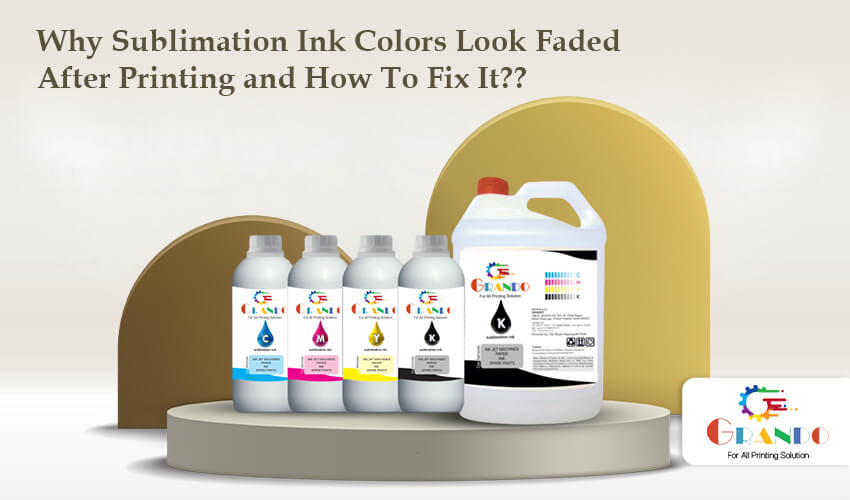
Ever had that sinking feeling when your freshly heat-pressed design looks more “vintage washed-out” than “vibrant and vivid”? You’re not the only one. Many people face this issue in sublimation printing. Your design might look great on screen and print fine on paper, but then the final product appears dull or faded.
Before you blame your design skills or throw your heat press out the window, take a deep breath. The issue is usually not your creativity—it’s a small technical glitch in the process. As soon as you know what you need to check, you can easily create light, long-lasting prints.
In this simple guide, we will explore why your sublimation ink colors aren’t brightening up as they should. We’ll also show you how to fix them without any confusion.
What is Sublimation Ink?
Sublimation ink is a special type of dye-based ink that turns into gas when exposed to heat and pressure, bonding directly with polyester fabric or polymer-coated surfaces. Unlike regular ink, sublimation ink becomes part of the material rather than sitting on top of it. This results in vibrant, long-lasting, and washable prints that don’t crack or peel over time.
It’s important to understand that sublimation ink is formulated for a very specific purpose—it works best with sublimation ink printers, sublimation transfer paper, and polyester-based materials.
What Type of Ink is Used for Sublimation?
Only sublimation ink works for the sublimation printing process. You cannot use pigment or dye inks as a substitute. Sublimation ink is engineered to vaporize at high temperatures and bond with synthetic fibers. Most sublimation ink printers are compatible with inks developed specifically for their print head technology.
When selecting the best sublimation ink, look for features like color vibrancy, compatibility with ICC profiles, and fade resistance. Also, make sure to check the sublimation ink price to match your quality needs and budget.
Common Reasons Why Sublimation Ink Colors Look Faded
1. Incorrect Temperature, Time, or Pressure
The holy trinity of sublimation printing—temperature, time, and pressure—needs to be just right. Even a slight variation can affect how well the sticks to the material.
- Too Low Temperature: The ink won’t fully sublimate.
- Too Much Pressure: The ink may smear or underperform.
- Insufficient Time: The transfer process remains incomplete.
Solution: Refer to your substrate’s recommended settings and always test before mass production.
2. Using the Wrong Side of the Sublimation Paper
Many people unknowingly print on the wrong (non-coated) side of the sublimation paper. That means the ink never properly transfers.
Solution: Ensure you’re printing on the bright, white-coated side of the paper.
3. Low-Quality Sublimation Ink or Expired Ink
Your prints are only as good as the ink you feed your printer. Cheap or expired ink can result in dull or faded outcomes.
Solution: Use premium-quality sublimation ink. At Grando.in.co, we supply top-grade sublimation inks tailored for vibrant output.
4. Incorrect Substrate Coating
Sublimation only works on substrates with a polymer coating. If you try sublimating on a non-coated item (like common cotton), the ink won’t bond.
Solution: Use polyester-based materials or polymer-coated blanks designed for sublimation.
5. Wrong Color Profiles or Printer Settings
Your RIP software, ICC profile, and printer settings all play a role in how colors print. If your colors look wrong, your ICC profile might not fit your ink and paper combo.
Solution: Always install the correct ICC profile provided by your ink supplier. Calibrate regularly.
6. Inadequate Drying Time for Prints
Printing and immediately pressing your transfer can cause the ink to smudge or result in low vibrancy.
Solution: Let your sublimation prints dry for at least 5–10 minutes before heat pressing.
Pro Tips to Get Vibrant Sublimation Ink Colors
- Use High-Quality Sublimation Paper: Not all papers are equal. Premium paper retains and releases ink more effectively.
- Maintain Your Printer Regularly: Clogged printheads can mess with color output.
- Avoid Excess Moisture: In wet areas like Surat, moisture can impact ink performance.
- Use a Color Chart: Always run a color chart test before large batches.
- Conduct Regular Print Head Alignment Checks
How Grando Can Help You Achieve Better Sublimation Output
At Grando India, we offer:
- High-quality Sublimation Inks compatible with major printer brands
- Premium Sublimation Paper Rolls and accessories
- Professional-Grade Sublimation Printers and printing machines
- Expert Consultation for print settings, ICC profiles, and troubleshooting
We’ve helped countless print businesses scale from trial-and-error frustration to production-level confidence with our tech support and reliable products.
FAQs: Faded Sublimation Ink Colors
Q1: Can I re-press a faded sublimation print?
Ans: Not effectively. Once the ink has been released, you can’t re-transfer it. Best to adjust settings and reprint.
Q2: Are all polyester fabrics good for sublimation?
Ans: No. Fabrics with less than 60% polyester will yield muted results.
Q3: Can I use sublimation ink on cotton?
Ans: You’ll need a special coating or a sublimation cotton spray. However, even with these, the results are still limited.
Q4: How do I know if my ink is expired?
Ans: Check the bottle for the manufacturing and expiry date. Also, look for sedimentation or color separation.
